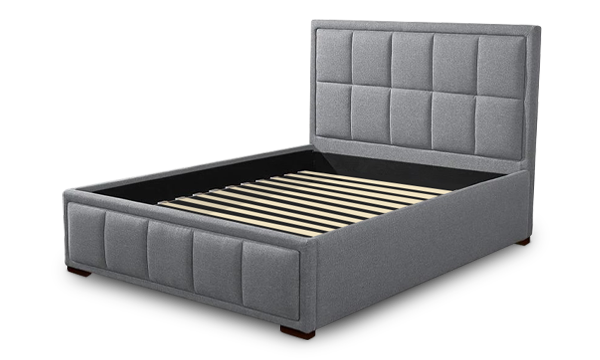In the quest for the perfect night’s sleep, the foundation on which your mattress rests plays a pivotal role. Many people find themselves at a crossroads, choosing between a traditional bed frame and a mattress foundation. Both options offer unique benefits and can significantly affect your mattress’s performance, longevity, and your overall sleep experience.
As a family constantly striving for the best rest possible, we’ve delved deep into the merits and drawbacks of bed frames and foundations, guiding you through our journey and discoveries.
Mattress Foundation vs Bed Frame
When deciding between a mattress foundation and a bed frame, understanding the specifics of each can significantly influence your choice, impacting everything from sleep quality to bedroom aesthetics.
Mattress Foundation
Characteristics:
- Design: Typically, foundations are simple, consisting of a wooden or metal frame covered with fabric, designed to support a mattress evenly across its surface.
- Support: They provide a stable, uniform support that is especially beneficial for memory foam, latex, and hybrid mattresses, helping to maintain the mattress’s shape and integrity over time.
- Height: Foundations usually offer minimal elevation from the floor compared to bed frames, which may be a consideration for those with mobility issues.
Pros:
- Enhanced Mattress Longevity: By distributing weight evenly, foundations can help prevent premature sagging and wear of the mattress.
- Simplified Aesthetic: For those who prefer a minimalist bedroom setup, foundations offer a straightforward, no-frills approach to mattress support.
- Cost-Effectiveness: Generally, foundations are less expensive than bed frames, especially those with elaborate designs or added features.
Cons:
- Limited Aesthetics: Unlike bed frames, foundations offer little in terms of design and may require a bed skirt or similar solution to integrate seamlessly into your bedroom decor.
- Reduced Storage: The lower profile of most foundations means less under-bed storage space.
Bed Frame
Characteristics:
- Design: Bed frames range from simple metal structures to elaborate designs with headboards, footboards, and even additional features like built-in storage or electronic adjustments.
- Support: Many bed frames are designed to be used with a box spring or foundation, though some modern designs include slats that can directly support a mattress.
- Height: Elevating the mattress higher off the ground, bed frames can make getting in and out of bed easier for many people.
Pros:
- Versatility in Design: Bed frames can be a focal point of bedroom decor, offering a wide range of styles to fit any aesthetic.
- Added Functionality: Many frames come with options for storage, electronic adjustments, or the ability to swap out headboards and footboards for a refreshed look.
- Elevation: The increased height can be beneficial for cleaning under the bed, improving airflow around the mattress, and aiding those who find lower beds challenging to navigate.
Cons:
- Cost: High-quality bed frames, especially those with additional features or intricate designs, can be a significant investment.
- Assembly and Space: Some bed frames can be complex to assemble and may take up more space, which could be a consideration in smaller rooms.
Pairing either option with a Puffy Lux Mattress ensures a comfortable, supportive sleep environment that caters to various needs and preferences.
Check out Puffy mattress reviews from real customers and see how we compare with other brands.
Do I Need a Bed Frame for My Mattress, or Is a Foundation Enough?
Deciding whether you need a bed frame or if a foundation alone suffices depends on several key factors:
- Mattress Type: Foam and latex mattresses often perform best on a solid foundation due to their need for even support, while innerspring mattresses might benefit from the additional cushioning of a box spring on a bed frame.
- Space and Style Preferences: Consider the layout and size of your bedroom, as well as your personal style. A bed frame can add character and dimension to a room, while a foundation offers a simplified look.
- Budget: Foundations generally present a more cost-effective solution, but investing in a bed frame might be worthwhile for the added benefits of design flexibility and elevation.
- Mobility and Accessibility: For those who have difficulty with lower beds, the elevation provided by a bed frame can make a significant difference in comfort and accessibility.
In our journey to create the ideal sleep setup, we weighed the pros and cons of bed frames and foundations against our family’s needs. Opting for a sturdy foundation for our Puffy Lux Mattress in the master bedroom provided the uniform support necessary for restorative sleep. However, for our guest room, a beautifully designed bed frame added charm and character to the space, making it welcoming and comfortable for visitors.
Use our store locator to find the closest furniture or mattress store near you and feel the cloudlike comfort of our Puffy Mattress in person.
Conclusion
The choice between a bed frame and a foundation largely depends on personal preferences, the type of mattress you own, and your bedroom’s design and space constraints. Both options have their merits, but ensuring your mattress receives proper support is paramount.
Whether you opt for the aesthetic appeal and elevation of a bed frame or the solid, uniform support of a foundation, pairing it with a high-quality mattress can elevate your sleep experience to new heights. Remember, the foundation you choose is not just about aesthetics; it’s about creating the optimal conditions for a good night’s sleep.

- Premium stitching.
- Heavy-duty wooden frame.
- Lifetime warranty.
- 101-night sleep trial.
- Free shipping and returns.












